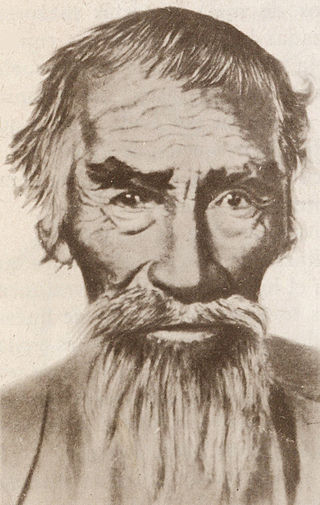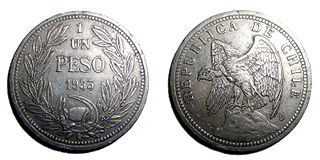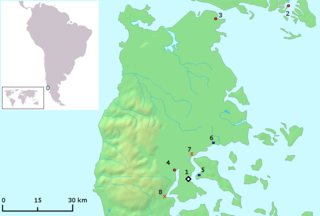
The Elqui River starts in the west Andes and flows into the Pacific Ocean near the Chilean city of La Serena. It is a wine and pisco producing area. Vicuña, the main town of the middle valley, was the home of Nobel Laureate poet Gabriela Mistral.

The Battle of the Maule was fought between a coalition of Mapuche people of Chile and the Inca Empire of Peru. Traditionally this battle is held to have occurred near what is now Maule River, in Central Chile. The account of Garcilaso de la Vega depicts the three-day battle, which is generally believed to have occurred in the reign of Tupac Inca Yupanqui.

This is a timeline of Chilean history, comprising important legal and territorial changes and political events in Chile and its predecessor states. To read about the background to these events, see History of Chile. See also the list of governors and presidents of Chile.

The Alicanto is a nocturnal mythological bird of the desert of Atacama, pertaining to Chilean mythology. Legend says that the alicanto's wings shine at night with beautiful metallic colors, and their eyes emit strange lights. The color of the wings may indicate the type of ore it eats, golden if from a gold mine and silvery if from a silver mine. Some descriptions also portray the color of the wings as copper-green.

Diego de Rosales was a Spanish chronicler and author of Historia General del Reino de Chile.

The Conquest of Chile is a period in Chilean historiography that starts with the arrival of Pedro de Valdivia to Chile in 1541 and ends with the death of Martín García Óñez de Loyola in the Battle of Curalaba in 1598, and the destruction of the Seven Cities in 1598–1604 in the Araucanía region.

Chañarcillo is a town and mine in the Atacama Desert of Copiapó Province, Atacama Region, Chile, located near Vallenar and 60 km from Copiapó. It is noted for its silver mining. The town grew after the Chañarcillo silver mine, discovered on May 16, 1832, by Juan Godoy, sparkled the Chilean silver rush. It grew in prominence in the second half of the nineteenth century and became important in the Atacama mining industry and one of the most important mines to the Chilean economy. It was connected by railway before 1862. Today the settlement is largely in ruins.

The Huarpes or Warpes are an indigenous people of Argentina, living in the Cuyo region. Some scholars assume that in the Huarpe language, this word means "sandy ground," but according to Arte y Vocabulario de la lengua general del Reino de Chile, written by Andrés Febrés in Lima in 1765, the word Cuyo comes from Araucanian cuyum puulli, meaning "sandy land" or "desert country".
The Poem of Almería is a medieval Latin epic poem in 3851⁄2 leonine hexameters. It was appended to the end of the Chronica Adefonsi imperatoris, an account of the reign of Alfonso VII of León and Castile, and narrates the victorious military campaign of 1147 that culminated in the conquest of the port of Almería. The poem, as it survives, is unfinished, abruptly ending mid-line before recounting the actual siege of Almería itself. Of its surviving lines, 293 consist of "dénombrement épique, a stirring roll-call of the chief members and contingents of the army".

Between 1830 and 1850, Chilean silver mining grew at an unprecedented pace which transformed mining into one of the country's principal sources of wealth. The rush caused rapid demographic, infrastructural, and economic expansion in the semi-arid Norte Chico mountains where the silver deposits lay. A number of Chileans made large fortunes in the rush and made investments in other areas of the economy of Chile. By the 1850s, the rush was in decline and lucrative silver mining definitively ended in the 1870s. At the same time, mining activity in Chile reoriented to saltpetre operations.

Juan Godoy was a Chilean farmer and miner who in 1832 discovered an outcrop (reventón) of silver 50 km (31 mi) south of Copiapó in Chañarcillo, sparking the Chilean silver rush.

In Chilean historiography, the wheat cycle refers to two episodes of booming wheat exports and related changes in society and agriculture. The first cycle occurred from 1687 to the independence wars and was caused by heavy demand in Peru. The importance of wheat had led the 18th century in Chile to be labelled the wheat century.

The Huilliche uprising of 1712 was an indigenous uprising against the Spanish encomenderos of the Chiloé Archipelago, which was then a part of the Captaincy General of Chile. The rebellion took place in the central part of the archipelago.

The Great Depression that begun 1929 was felt strongly in Chile from 1930 to 1932. Saltpetre and copper exports collapsed. The World Economic Survey of the League of Nations declared Chile the worst affected nation by the depression. Such economic devastation worsened Chile's economic prosperity, highlighted particularly in 1932 that exemplifies a rapid fall in exports, imports, GDP and the value of industrial production from pre-depression levels. Chiles exports dropped from US$279m in 1929 to US$35m in 1932, which in real terms corresponds to 1/6 of export level in 1929. In accordance to this time period, Chile's imports fell from US$197m in 1929 to US$26m in 1932. Similarly, real GDP dropped from 100 in 1929 to 67 in 1932, contributed by the fall of the value of production from 100 in 1929 to 77 in 1932 alongside a rapid decrease in the average annual production that reached the equivalent to one quarter of 1929 levels in December 1932. Alongside a decrease in employment in the mining sector, in terms of GDP and productive activity, mining dropped to 26.3 in 1932 from 1929 levels of 100.

Inca rule in Chile was brief, it lasted from the 1470s to the 1530s when the Inca Empire was absorbed by Spain. The main settlements of the Inca Empire in Chile lay along the Aconcagua, Mapocho and Maipo rivers. Quillota in Aconcagua Valley was likely the Incas' foremost settlement. The bulk of the people conquered by the Incas in Central Chile were Diaguitas and part of the Promaucae. Incas appear to have distinguished between a "province of Chile" and a "province of Copayapo" neighboring it to the north. In Aconcagua Valley the Incas settled people from the areas of Arequipa and possibly also the Lake Titicaca.
During most of Chile's history, from 1500 to the present, mining has been an important economic activity. 16th century mining was oriented towards the exploitation of gold placer deposits using encomienda labour. After a period of decline in the 17th century mining resurged in the 18th and early 19th century this time revolving chiefly around silver. In the 1870s silver mining declined sharply. Chile took over the highly lucrative saltpetre mining districts of Peru and Bolivia in the War of the Pacific (1879–83). In the first half of the 20th century copper mining overshadowed the declining saltpetre mining.

Banditry was a considerable phenomenon in 19th century and early 20th century Central Chile and Araucanía. Many bandits achieved legendary status for their brutality and others for being regarded folk heroes. The bandits usually preyed on haciendas and their inquilinos.

Osvaldo Silva Galdames was a Chilean historian active within the field of prehistory. He was a founder of the academic history journals Cuadernos de Historia and Revista de Historia Indígena, as well being a driving force behind the establishment of the Magíster de Historia con mención en etnohistoria at the University of Chile. At the same university he served as director of the department for Historical Science for many years. Among Silva's contributions to history was a proposal for a different chronology of the Inca rule in Chile.
The Parliament of Tapihue of 1825 was a diplomatic agreement between fourteen Mapuche reductions and the newly established Republic of Chile. The Mapuche reductions were represented by the lonko Juan Mariluán and the republic by Colonel Pedro Barnachea. The agreement was aimed to end the Guerra a muerte conflict that had grown out from the Chilean War of Independence. It was also a means for the Chilean government to establish relations with Mapuches.
Agua Amarga is a silver deposit and defunct mining district in Chile's Atacama Region. It is located 30 km south of Vallenar. Agua Amarga was discovered in 1811 and its silver was instrumental to finance the Chilean War of Independence. An enquiry by Ignacy Domeyko tells of 150 individual mines active in Agua Amarga in 1822. Calera, Colorada and Aris are mentioned as the most productive mines of Agua Amarga.












